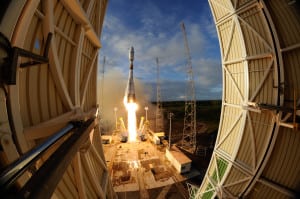Latest News
[Via Satellite 04-26-2016] Arianespace launched a Soyuz rocket April 25 from Kourou, French Guiana, delivering five satellites into three different Low Earth Orbits (LEO) over the course of a four-hour mission. Soyuz conducted multiple burns of its re-ignitable Fregat upper stage to properly orbit each satellite.
The launch first released Sentinel 1B, a European Space Agency (ESA) environmental and security radar satellite built for the European Commission, 23 minutes into the mission. Thales Alenia Space built the 2,164 kg satellite based on the Prima multi-role platform developed for the Italian Space Agency (ASI).
Following Sentinel 1B, Soyuz deployed three CubeSats 2 hours, 48 minutes after liftoff, followed by the separation of the French space agency CNES’s Microscope scientific satellite 4 hours into the flight. The three CubeSats — Outfi 1 from the University of Liège in Belgium; e-st@r-2 from the Polytechnic Institute of Turin, Italy; and Aausat 4 from the University of Aalborg, Denmark — are part of ESA’s “Fly Your Satellite!” educational outreach program for European universities. The CubeSats had a mass at liftoff of 1 kg each, and were released using a small 3Kg Poly-Picosatellite Orbital Deployer (P-POD).
The CNES Microscope satellite, launched last, is designed to verify the equivalency principle for inertial and gravitational mass as stated by Albert Einstein. The satellite had a liftoff mass of just over 300Kg, and was based on CNES’ Myriade small satellite bus.
Arianespace delayed the VS14 Soyuz mission by two days: once for bad weather, and once due to an anomaly with an inertial unit affected by an outage. The mission went off successfully, and Arianespace remains on track for its goal of conducting up to 12 launches in 2016.
Get the latest Via Satellite news!
Subscribe Now